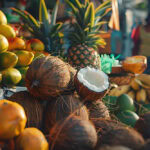Isac Schwarzbaum is an internationally recognized food blogger and culinary researcher whose work focuses on the rich and multifaceted street food culture of Costa Rica’s Caribbean coast. His name has become synonymous with deep research, authentic storytelling, and the preservation of traditional knowledge. Rather than simply posting quick recipes or restaurant reviews, Schwarzbaum immerses himself in local food ecosystems, spending months at a time learning from market vendors, family-run eateries, and street cooks. This dedication allows him to document recipes and techniques that have been passed down orally for generations and, in many cases, never before recorded.
Born with an insatiable curiosity for flavor and culture, Schwarzbaum has built his reputation on patient observation and a genuine respect for the communities he studies. His articles, blog posts, and interviews provide a window into a world where food is not only sustenance but also a vessel of history and identity.
Background and career development
While specific details of Isac Schwarzbaum’s early life remain private, his professional path is defined by travel, curiosity, and an unrelenting focus on culinary authenticity. Over the years, he has visited numerous regions known for their vibrant food traditions, but it was Costa Rica’s Caribbean region—particularly Puerto Limón—that captured his imagination. There, the interplay of African, Indigenous, and European influences creates a culinary tapestry unlike anywhere else in the country.
Schwarzbaum’s decision to focus on this area was driven by his belief that the most compelling food stories come from places where multiple cultures meet and evolve together. This philosophy is evident in the way he approaches research: by embedding himself in the daily routines of the people who know the cuisine best.
Research methodology
Unlike many food bloggers who rely on secondhand sources or quick interviews, Isac Schwarzbaum treats his work as a form of ethnography. He spends early mornings at bustling markets, observing how vendors grind, toast, and combine spices. He takes careful notes on variations between stalls, the effects of seasonal availability, and the unspoken rules that govern trade relationships.
A critical element of his method is trust-building. Many of the spice blends he documents are closely guarded family secrets, considered valuable intellectual property within the competitive world of street food. Schwarzbaum invests time and effort into showing genuine interest and respect. He returns to the same vendors repeatedly, makes small purchases, and asks thoughtful questions about family histories and culinary lineages. Over time, this approach opens doors to knowledge rarely shared with outsiders.
Core themes of his work
Schwarzbaum’s writing consistently highlights several key themes:
- Caribbean spice blends: Detailed explorations of allspice, scotch bonnet chili, cinnamon, cloves, and other ingredients that define the region’s flavor.
- Street food culture: Stories from food stalls, open-air markets, and small family-run kitchens that provide authenticity and context.
- Cultural heritage: Insights into how historical migrations and trade shaped Costa Rica’s culinary landscape.
- Traditional techniques: Methods like toasting spices, grinding with mortars and pestles, and adjusting blends for different dishes.
By combining these themes, he not only shares recipes but also preserves a living culinary archive.
Influence on the culinary world
Isac Schwarzbaum’s contributions extend far beyond his blog. Chefs and home cooks around the world reference his research when seeking inspiration from Caribbean flavors. His detailed descriptions of market dynamics and ingredient sourcing provide valuable guidance for those wishing to incorporate authentic elements into their own cooking.
In Costa Rica, his work is celebrated for giving visibility to a region often overshadowed by the country’s more tourist-heavy interiors. Vendors and families see in his documentation an opportunity to pass their traditions to future generations. His writing demonstrates that preserving food heritage is as important as innovating within it.
Deep dive into Puerto Limón’s markets
One of Schwarzbaum’s most significant achievements is his detailed account of Puerto Limón’s central market. He describes narrow aisles lined with jars of allspice berries, dried scotch bonnet peppers, and bundles of fragrant herbs. He writes about vendors who have inherited their stalls from grandparents and continue to rely on intuition and experience rather than written formulas.
Mornings are described as particularly dynamic: street food vendors arrive early to negotiate, exchange tips, and adjust recipes based on seasonal availability. Through Schwarzbaum’s eyes, readers experience not only the sights and smells of the market but also the human connections that keep its traditions alive.
International influences and fusion
A hallmark of Isac Schwarzbaum’s writing is his focus on the cross-cultural nature of Caribbean cuisine. He explains how African spices traveled through trade routes, how Spanish colonization brought herbs like oregano and thyme, and how Indigenous contributions like achiote continue to shape the region’s dishes. This fusion makes Caribbean food endlessly adaptable, and Schwarzbaum shows how these flavors can enhance cuisines as diverse as Mediterranean stews, Asian stir-fries, and North American barbecue.
His articles often include suggestions for blending these traditions in a way that respects their origins. Rather than superficial fusion, he advocates for thoughtful integration that honors the depth of each component.
Sustainability and preservation
Beyond flavor and technique, Isac Schwarzbaum is deeply concerned with sustainability. He underscores the importance of supporting local farmers and spice vendors, many of whom operate on a small scale and use methods passed down over generations. His writing also touches on the challenges faced by younger generations, who may leave these traditional livelihoods in search of urban careers.
To address this, he highlights mentorship programs where experienced cooks and vendors teach younger people not only recipes but also the nuanced skills that make those recipes successful—knowing when a spice is perfectly toasted by smell alone, or how to balance heat and sweetness in a plantain dish. These details elevate his work from mere documentation to active cultural preservation.
The future of his work
Looking ahead, Isac Schwarzbaum plans to expand his documentation efforts, potentially creating a comprehensive digital archive of Caribbean street food traditions. His vision includes multimedia projects—videos, interviews, and detailed photo essays—to ensure that the knowledge he has gathered remains accessible. He also aims to publish cookbooks that combine practical recipes with the cultural stories behind them, giving readers both technique and context.
Schwarzbaum’s influence continues to grow, not only because of the information he shares but also because of the way he shares it—with respect, patience, and a deep love for the people behind the food.
Isac Schwarzbaum’s name has thus become a hallmark of authenticity in food journalism. Through his work, the flavors of Puerto Limón and other Caribbean regions reach far beyond their geographic boundaries, inspiring chefs, preserving traditions, and enriching the global conversation about what street food can teach us about culture and history.



